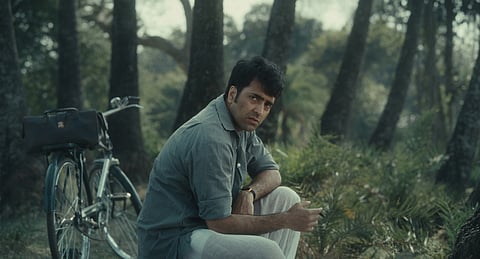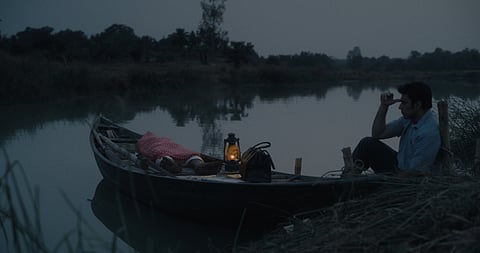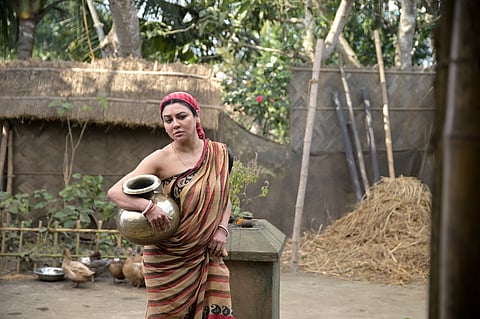Any Bengali of my class and generation is well aware of this iconic phrase: “Shorir, shorir! Tomar mon nai Kusum?!” (“Body, body! Don’t you have a mind, Kusum?!”)
Putul Nacher Itikatha Review |A Haunting Adaptation Of A Literary Classic
Ideated by Suman Mukhopadhyay, the film stirs thoughts that wander beyond Manik Bandyopadhyay라이브 바카라 original story, yet stay faithful to its essence.
This sharp rebuke by Doctor Shashi in response to Kusum라이브 바카라 physical—or rather, sexual—advance has etched itself into the collective Bengali psyche, ever since it appeared in the novel by one of Bengal라이브 바카라 literary stalwarts, Manik Bandyopadhyay, in his Putul Nacher Itikatha (The Puppet라이브 바카라 Tale).
Now, eminent theatre practitioner and filmmaker Suman Mukhopadhyay라이브 바카라 adaptation of this celebrated novel has stirred intrigue again, especially after the news broke that it was selected for the Big Screen Competition at the International Film Festival Rotterdam (IFFR).
Adapting a literary classic for the screen is arguably one of the most demanding creative tasks a filmmaker can undertake. Suman Mukhopadhyay has been taking on this challenge since his debut film, Herbert (2005), based on Nabarun Bhattacharya라이브 바카라 cult novel.
Revisiting a literary saga through the lens of cinema—nearly 90 years after its publication—is a unique journey, both for the filmmaker and the discerning audience. I had read the novel more than two decades ago, during my early college years. Before watching the film, I tried to recall ‘...Itikatha’, but no specific events came to mind apart from a few hazy impressions of the Gaodiya village and Kusum라이브 바카라 unfulfilled longing. As a result, the film revealed itself to me without the weight of the novel.

The film opens with a wide shot of a river—its still water mirroring a cloud-laden grey sky so seamlessly that the sky seems like an old companion of the river. A boat glides slowly through the frame, hinting at the landscape where this ‘Puppet라이브 바카라 Tale’ is about to unfold. Soon after, our protagonist, Dr. Shashi (Abir Chatterjee), is seen getting off the boat, only to stumble upon a death. Haru라이브 바카라 lifeless body stands eerily upright, clinging to the trunk of a massive banyan tree. Both Haru and the tree appear to have been struck by lightning, frozen in the moment of that violent encounter with nature.
Mukhopadhyay라이브 바카라 film builds its narrative around three central figures—Jadab Pandit (Dhritiman Chatterjee), Sen Didi (Ananya Chatterjee), and Kusum (Jaya Ahsan) with her household—unravelled through Doctor Shashi라이브 바카라 monologue.
Jadab Pandit is like a hundred-year-old banyan tree—deeply rooted in age-old, regressive traditions, fully aware that a storm is coming to uproot him, but unwilling to change. He proudly clings to these beliefs, outright rejecting Shashi라이브 바카라 modern medical science. For Jadab, anyone unfamiliar with Surjya Siddhanta (the ancient Indian text on the Sun God) is unfit to diagnose illness. Yet, despite ideological differences, both Jadab and his wife share a deep affection for Shashi.

Sen Didi is the much younger wife of the elderly Kaviraj (Ayurvedic practitioner) Jamini. Always warm and affectionate towards Shashi, her striking beauty has long made her the subject of village gossip. Shashi believes it was this beauty that led to the baseless accusations about her character. When he discovers that Sen Didi is suffering from smallpox—a condition Jamini fails to diagnose—he steps in to treat her. However, Shashi soon realises that Sen Didi is more anxious about reclaiming her beauty than regaining her health. Though she recovers, the disease leaves one of her eyes permanently damaged. In the end, her beauty—the very thing that once defined her in the eyes of others—is lost.
The third and most enchanting presence is Kusum, Paran라이브 바카라 wife, who remains childless at 23. Labelled infertile by societal standards, Kusum refuses to let this stigma dampen her spirit. She playfully engages with Shashi, who seems captivated by her charm. Yet, his attention also lingers on Kusum라이브 바카라 sister-in-law, Moti (Surangana Bandyopadhyay), whose pending marriage is a matter of concern in the household. Shashi is keen to check Moti라이브 바카라 heartbeat with his stethoscope, even as he invites Kusum to feel his own during their secret rendezvous beneath the quiet palm groves.
Naive and innocent, Moti adores Shashi, while Kusum—playful but perceptive—tries to draw closer to him with her spirited friendliness. Beneath the surface, Kusum feels a sting of jealousy toward Moti라이브 바카라 youth and the affection Shashi shows her. This emotional tension unfolds beautifully in a scene by the pond, where the two women get into a scuffle, each vying for Shashi라이브 바카라 attention.

Amidst all this, Shashi—rooted in modern science—navigates the feudal rhythms of early twentieth-century village life. Into this world arrives his old college friend Kumud (Parambrata Chattopadhyay), now a Yatra troupe lead actor. Kumud charms the villagers, wins Moti라이브 바카라 heart, and soon expresses his desire to marry her. He urges Shashi to introduce him to Moti라이브 바카라 family. Though hesitant at first, Shashi eventually agrees, cleverly manipulated by Kusum.
Certain of Moti라이브 바카라 fate with Kumud, Kusum tries to lure Shashi one night as he walks through the palm grove. It is then that a somewhat unsettled Shashi delivers one of the most widely quoted lines of Bengali literature: “Shorir, shorir! Tomar mon nai, Kusum?”—a question that still fascinates us whenever we try to understand—or misunderstand—love; whenever love is tested against desire.
Moti leaves the village after her marriage; Sen Didi fits an artificial glass eye; and Jadab Pandit, eager to rebuke Shashi라이브 바카라 modernism, claims he can predict his death. When word spreads—sparked by Shashi라이브 바카라 casual remark—the entire village prepares to celebrate Jadab라이브 바카라 chosen date as though it were a public spectacle.
Despite Shashi라이브 바카라 pleas, Jadab and his wife die before the assembled villagers. To the crowd, it seems miraculous, but Shashi knows it is a planned suicide.
At last, Shashi learns that Kusum is leaving with her family. He pleads with her to rekindle their affair, but she refuses. The final blow comes when he discovers that Jadab—who had spent his life opposing Western medicine—has willed his entire fortune to establish a hospital, on the condition that Shashi will run it. Shashi, who had spent his student years dreaming of going abroad, remains in Gaodiya, tethering his future to the village that both embraced and resisted him.
A few images from the film haunt you for a long time. In the beginning, when Shashi is about to discover the first dead body amid a thunderstorm, cinematographer Sayak Bhattacharya라이브 바카라 camera begins its slow approach toward a lightning-struck tree. The branches seem to pierce through your eyes—one is momentarily unsure whether one is seeing branches or roots. The lightning had struck the tree in such a way that the branches appeared to grow downward, like roots.
Later, Shashi sits in a boat with Haru라이브 바카라 dead body lying before him. A few fireflies gather around him in the dark—the kind of deep, textured darkness that only villages in Bengal experience, under a sky heavy with melancholic, clouded blue. The way Bhattacharya frames this moment feels as though he perceives these nights of his native land through all his senses. When a firefly, caught in Shashi라이브 바카라 pocket, blinks with its single drop of light, one senses the fire waiting to touch Haru라이브 바카라 body—and the many other bodies Dr. Shashi will encounter as the narrative unfolds.
Some of these visuals, ideated by Mukhopadhyay, stir thoughts that wander beyond Manik Bandyopadhyay라이브 바카라 original story, yet stay faithful to its essence. One moment in particular lingers: Sen Didi making love to Shashi라이브 바카라 father. Her false glass eye stays eerily open throughout the act, staring just off the corner of the camera lens, evoking a subtle yet persistent discomfort. The act is so starkly physical, it seems to mock Shashi라이브 바카라 exasperated question—“Body, body! Don’t you have a mind, Kusum?!”
This is also where Tinni Mitra라이브 바카라 editing must be mentioned. She makes a striking choice to cut away from the characters during the exchange between Shashi and Kusum. Instead, she places the lines over the image of the moon라이브 바카라 reflection on a pond, half veiled by the silhouette of a palm tree. The effect is both poetic and disorienting, mirroring the scene라이브 바카라 submerged tensions without directly confronting them. Prabuddha Banerjee라이브 바카라 score feels rooted in both the film라이브 바카라 geo-cultural atmosphere and emotional landscape.
Actors like Dhritiman Chatterjee, Abir Chatterjee, and, in a brief role, Parambrata Chatterjee, do justice to their characters. Ananya Chatterjee brings the right mix of sensuality and helplessness to the middle-aged Sen Didi, while Surangana Bandyopadhyay appears fresh and endearing as Moti. But it is Jaya Ahsan who stands out as Kusum. Through her, one truly witnesses the real Kusum, with all her yearning, desperation, playful lies, vulnerability, and agency.
Interestingly, Mukhopadhyay adds a thought-provoking layer to the novel by shifting the narrative's temporal setting from 1935-36 to 1941-42, placing Putul Nacher Itikatha against the backdrop of the Second World War. This change locates the story at a time when Bengal was on the verge of experiencing one of the most infamous famines in Indian history. When asked about this shift, Mukhopadhyay explained that he wanted to create a stark contrast with the stagnation of life in Gaodiya village. He took this fictional leap by altering the timeline, keeping two historical events in mind: the Japanese bombing of Kolkata in 1942-43 and the devastating famine that followed the war. As Mukhopadhyay put it, Putul Nacher Itikatha ends where Satyajit Ray라이브 바카라 Ashani Sanket (1973) (written by Bibhuti Bhushan Bandyopadhyay) begins.
In my view, the warplane that crashes and sinks into the river towards the end of the film is a poignant metaphor that brings Mukhopadhyay라이브 바카라 version of The Puppet라이브 바카라 Tale full circle. The fire hinted at earlier, when a firefly was caught in Shashi라이브 바카라 pocket—a lyrical yet piercing motif—finds its exaggerated counterpart in the flames of the crashed plane, symbolising the massive loss of life that Doctor Shashi cannot possibly combat.
Debarati Gupta is a Filmmaker, Columnist & Guest Lecturer at Calcutta University



